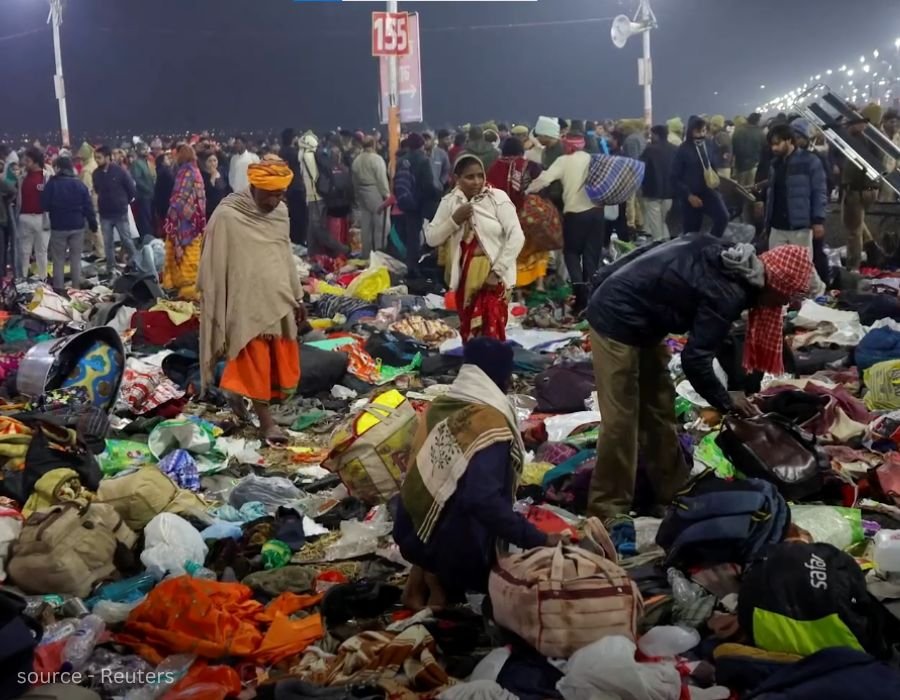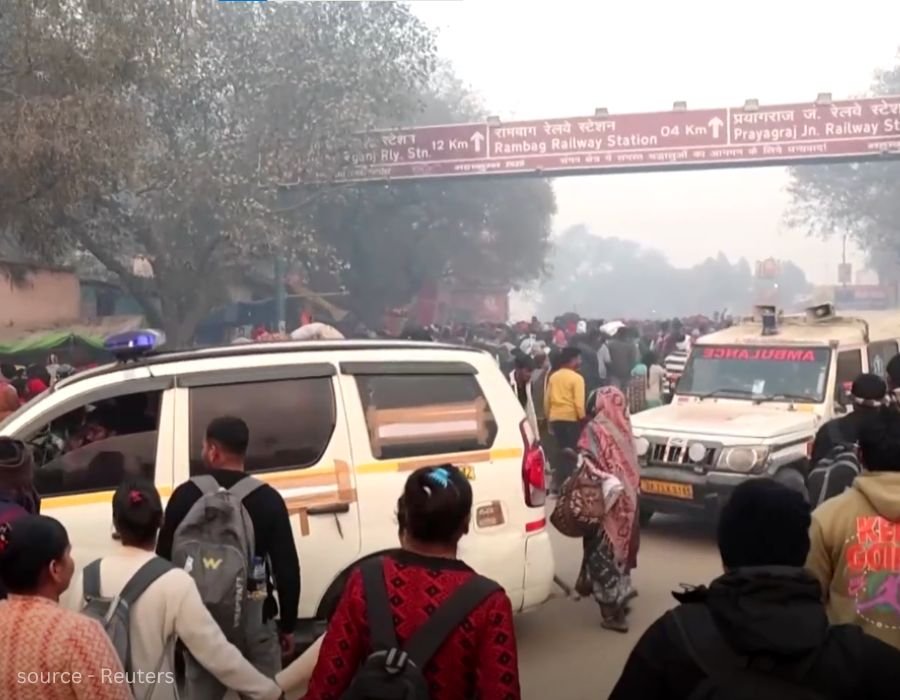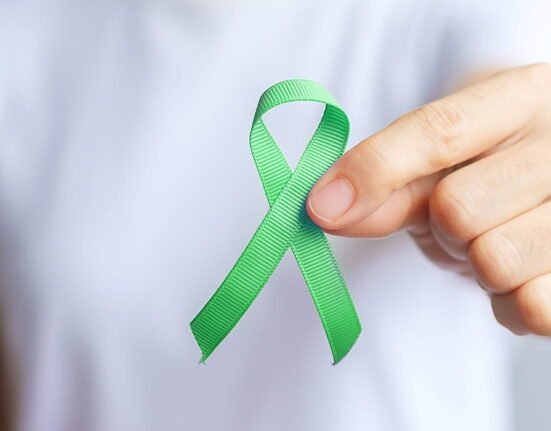Recently, tragic events have occurred at the Maha Kumbh Mela, one of the largest religious gatherings in the world. A devastating stampede at the 2025 Maha Kumbh in Prayagraj highlights the risks posed by poor crowd control management, claiming the lives of at least 30 people and leaving 60 injured. The psychological effects of such catastrophes are frequently overlooked, but the physical effects are readily apparent. Long-term emotional discomfort, anxiety, and trauma can affect survivors, victims’ families, and even spectators as well. This article explores the psychological effects of the Maha Kumbh stampede, looking at how people deal with pain, loss, and terror as well as the role crowd psychology plays in such events.
Psychological Impact on Survivors and Families
Those who experience stampedes may suffer severe psychological damage as a result of these horrific incidents. Post-Traumatic Stress Disorder (PTSD), which comprises anxiety, flashbacks, nightmares, and a fear of crowded places, is frequently experienced by survivors. Many people can additionally suffer from survivor’s guilt, contemplating why they survived when others passed away.
Grief can overwhelm families who have lost loved ones. It is more difficult to process the loss because of the quick and tragic nature of death in a stampede. Because such grieving is frequently accompanied by sentiments of wrath, helplessness, and remorse, experts argue that it may be more complex than natural bereavement.
Psychological Impact of Stampedes: Trauma, Coping, and Expert Insights
Trauma psychologists strongly recommend therapy for survivors and their families as a crucial step in processing emotions, coping with distress, and mitigating symptoms of post-traumatic stress disorder (PTSD). People can express their emotions, work through their loss, and create healthy coping strategies in a safe environment with professional counselling. Furthermore, participating in support groups or group therapy can be quite helpful since it enables people to connect with others who have gone through comparable traumatic situations. Through group support, this sense of mutual understanding encourages emotional comfort, lessens feelings of loneliness, and advances recovery.

In addition to traditional treatment, spiritual and religious healing techniques hold significance for giving trauma survivors solace and security. In times of difficulty, spiritual therapy, religious rituals, and prayer provide a sense of continuity, hope, and serenity. Many people find that faith-based methods support resilience, help them regain emotional equilibrium, and give them a greater sense of meaning and purpose in life.
Furthermore, stress-reduction strategies and mindfulness-based interventions are useful instruments for reducing anxiety and fostering emotional health. People can control their emotions, manage stress reactions, and develop inner peace by using techniques including progressive muscle relaxation, deep breathing exercises, meditation, and guided visualization. Using these holistic healing techniques on a regular basis can help promote long-term recovery, greatly increase psychological resilience, and improve overall mental health.
Crowd Psychology and Stampedes: The Science Behind the Chaos
Herd mentality is the tendency for people to follow the behaviour of others rather than making their own decisions in large groups. This can easily turn into panic, in which fear causes people to behave unreasonably.
How Panic Spreads in Crowds
People frequently suffer from deindividuation in huge crowds, which causes them to lose their sense of self and behave in ways they wouldn’t usually, which can occasionally lead to aggressive conduct or a disregard for safety warnings. Chain responses, in which terror from a small number of people spreads quickly and causes the entire crowd to move in an unmanageable and chaotic way, can make this worse. Furthermore, cognitive overload plays a significant role, as the overwhelming presence of thousands of people makes it difficult for the brain to process information effectively, leading to impulsive and sometimes irrational decisions. Together, these psychological factors contribute to the dangers of crowd behaviour.
Psychological Strategies for Crowd Control
During big events, using efficient crowd control techniques may substantially reduce dangers and improve safety. By teaching participants how to move safely in crowds, awareness programs help reduce impulsive reactions and panic-driven behaviour. Additionally, people can be gently guided toward controlled and orderly movement by using behavioural nudging techniques like color-coded zones, strategically placed barriers, and clear signage, which can lessen confusion and traffic.
Another key strategy is to train security personnel in psychology, shifting from force-based crowd control to a community-focused management approach. By guiding rather than restricting people, authorities can foster cooperation and ensure smoother crowd dynamics, ultimately creating a safer and more organized environment.
Grief, Rituals, and the Psychological Significance of Religious Gatherings
The Maha Kumbh Mela is a profoundly spiritual event for many people, in addition to being a festival. For some people, the tragedy of a stampede at such a holy event might lead to a crisis of faith; for others, it can reinforce their core beliefs.
The Role of Rituals in Healing
Collective mourning plays a vital role in helping communities cope with grief, as mass prayers and rituals provide a shared space for emotional expression and reinforce social bonds. By giving bereaved families a sense of closure and comfort, symbolic actions of closure like lighting lamps, submerging ashes, or carrying out particular rituals can provide psychological solace. Furthermore, many people believe that their religious convictions provide them courage, enabling them to accept loss as a necessary component of fate or divine will. These social and spiritual activities promote healing by providing consolation and emotional support during challenging situations.
Risk Perception and Public Safety in Mass Gatherings
People continue to disregard safety warnings and crowded venues despite the frequent stampedes at religious festivals. Cognitive biases cause people to underestimate risk, which influences this behaviour.
Why People Ignore Safety Warnings
Psychological factors often shape how people perceive and respond to threats in crowded environments. Optimism bias leads individuals to underestimate risks, making them less cautious and more willing to take chances, as they believe disasters are unlikely to happen to them. This effect is reinforced by the familiarity heuristic, where people assume a location is safe simply because they have been there before without harm. Additionally, social influence plays a crucial role—people tend to mimic those around them, so if others ignore safety measures, they are likely to do the same. Together, these cognitive biases create a false sense of security, increasing vulnerability to danger.

Behavioural Interventions for Crowd Safety
Setting arrangements for organized safety procedures can greatly enhance crowd control and lower risks during big events. Mandatory registration, through ticketing or wristbands, helps regulate the number of attendees, preventing overcrowding and ensuring better control. Additionally, by holding simulated drills, people can learn emergency procedures and gain the knowledge and readiness necessary to respond appropriately in emergency situations.
Incentivized safety procedures, like providing priority access or special advantages to participants who follow safety rules, can further encourage compliance and create a more secure and orderly atmosphere for all.
Media Exposure and Emotional Overload
Individuals who are constantly exposed to distressing news may get emotionally overwhelmed and experience long-lasting psychological repercussions. Although the media is essential for educating the public and increasing awareness, excessive and repetitious images of pain can cause desensitization, a condition in which people grow numb to human suffering as a result of being exposed to devastating events on a regular basis. Additionally, viewers may suffer increased worry, fear, and emotional distress as a result of vicarious trauma, especially if they have previously experienced trauma. Instead of delivering helpful facts, sensationalized news leads to fear and confusion, which further fuels public panic.
Furthermore, it raises ethical difficulties when the media infringes on the privacy of individuals impacted by disasters by frequently posing invasive and hurtful queries at crucial times. For those who are sensitive to such content, excessive depictions of violence, particularly when they occur without warning, can be quite upsetting. In order to ensure that news coverage strikes a balance between increasing knowledge and safeguarding the audience’s psychological wellbeing, responsible journalism should place a high priority on ethical reporting.
Responsible Media Coverage
While keeping the public informed, a responsible approach to news coverage can help lessen the detrimental psychological effects of distressing news or information. In order to present a more positive viewpoint, balanced reporting should not just highlight loss and destruction but also solutions, relief efforts, and recovery attempts. Furthermore, by putting trigger warnings before graphic content, sensitive people can either get ready or decide not to view upsetting images. Highlighting survivor experiences, which demonstrate resilience and hope and serve to balance out feelings of fear and despair, is another essential component. The media can foster a news environment that is more encouraging and psychologically sensitive by implementing these ethical reporting methods.
Read more: Media Psychology: Influence of Media on Behavior and Perception
What to Do If You Are in a Stampede Situation?
Being caught in a stampede is a gruesome event, knowing how to respond can save a life. Falling increases the chance of getting trampled, so it’s important to stay upright. If you do fall, try to get back up as soon as you can. Moving laterally is safer than pressing straight into the crowd since it enhances your chances of finding an exit. In crowded places, you can avoid suffocating by protecting your chest with your arms to create breathing space. Avoiding inflexible obstacles is also crucial; if you are confined, situating oneself close to an open space rather than a sturdy building can increase your chances of escaping. Above all, adhere to official directives at all times, relying on security guards to direct you towards safety.
Another way to prevent casualties in a stampede is to assist others. Since fear spreads quickly in these kinds of circumstances, maintaining composure and supporting others might help lessen panic. If someone falls and you are in a position to help, pull them up by their arms rather than attempting to lift their entire body, which may be difficult in a crowded situation. Furthermore, authorities can take preventative action and stop harmful situations before they happen by reporting unsafe conditions in advance, such as crowding or weakened structures. In times of disaster, people can safeguard themselves and help others by remaining alert and prepared.
Conclusion
The tragic Maha Kumbh stampede serves as a cautionary tale of the danger’s at large gatherings. While structural failures and crowd mismanagement played a major role, the psychological aspects of human behaviour in large groups cannot be ignored. Future emergencies can be avoided and survivors’ healing can be aided by having a solid understanding of crowd psychology, risk perception, trauma recovery, and responsible media reporting. Going forward, maintaining religious meetings as safe places for devotion rather than catastrophes of despair will require a multidisciplinary strategy that combines community involvement, psychological insights, and infrastructure upgrades.
References +
Indian Express, DD News, ReseachGate https://www.researchgate.net/publication/316308534_Human_Stampedes_What_do_we_know_today
FAQs
1. I was present at the Maha Kumbh during the stampede, and even though I wasn’t injured, I feel extremely anxious and can’t stop thinking about it. Is this normal?
Yes, it is completely normal to feel anxious, distressed, or even have recurring thoughts about the event. Many people who witness or experience traumatic incidents develop acute stress reactions or even Post-Traumatic Stress Disorder (PTSD). You may experience nightmares, flashbacks, or fear of crowded places. Seeking professional counselling, practicing mindfulness techniques, and talking to support groups can help process these emotions and aid in recovery.
2. Why do stampedes keep happening at religious gatherings despite authorities taking precautions?
Stampedes often occur due to overcrowding, poor crowd control, and sudden panic among attendees. People tend to follow the movements of others (herd mentality), which can lead to chaotic situations. Additionally, many underestimate risks due to optimism bias, believing nothing bad will happen to them. Proper infrastructure, better crowd management strategies, and public awareness about movement safety can help prevent such disasters.
3. I lost a loved one in the stampede, and my family is struggling to cope. What can we do to heal?
Losing someone in such a tragic manner can cause immense grief, anger, and helplessness. Seeking grief counselling, participating in religious rituals, and joining support groups can help in processing emotions. Spiritual practices may offer comfort, while therapy provides coping mechanisms to navigate grief in a healthy way. Surrounding yourself with a supportive community can also ease the healing process.
4. The media coverage of the stampede was overwhelming. I couldn’t stop watching, but now I feel emotionally drained and anxious. Why does this happen?
Excessive exposure to distressing news can cause vicarious trauma, where you absorb the emotional distress of others, even if you weren’t directly involved. The repeated visuals of suffering can heighten anxiety, fear, and emotional numbness. To protect your mental health, try limiting your exposure, seeking balanced news sources, and engaging in calming activities like meditation or spending time with loved ones.
5. If I ever find myself in a stampede situation, what should I do to survive?
In a stampede, your priority should be to stay on your feet, move laterally (sideways) instead of against the crowd, and protect your chest with your arms to maintain breathing space. If you fall, try to get up immediately by rolling to your side and using your arms to push up. Avoid rigid barriers and follow emergency exits if available. Staying calm and assisting others, when possible, can also help reduce panic-driven chaos.













Leave feedback about this